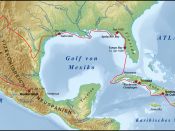In Alvar Nunez Cabeza de Vaca's Relacion, Cabeza de Vaca writes an account of his disastrous expedition to the New World, as well as providing a legal document in which the rhetoric of his narrative transforms his story of failure into a story of success. In chapter thirty-four, Cabeza de Vaca uses the three elements of rhetoric; ethos, logos, and pathos, to express that Spanish law is unsuitable for the circumstances encountered in the New World.
During the sixteenth century, Spanish expeditions to the New World were pursued under the power of the Spanish King, who enforces Spanish law. Specific people were appointed certain positions on these journeys and the entire crew was expected to follow Spanish law and fulfill their responsibilities, on of which includes converting any natives to Christianity. Despite the fact Cabeza de Vaca essentially failed as being treasurer of his expedition, he believes that he, unlike the majority of the other Spaniards, carried out Spanish law correctly and is willing to prove himself to his King with his account.
Throughout his document, Cabeza de Vaca carefully selects his choice of words to convince the King he is not one of the men responsible for the deterioration of the voyage. The purpose of chapter thirty-four is to specifically demonstrate how the Christians differed from Cabeza de Vaca and his men in carrying out their duties as Spaniards and as Christians. Since Cabeza de Vaca witnessed the disasters that happened, he doesn't hold Spanish law in high regards. He also believes the King should change certain aspects in order for a society to run successfully in a new environment as well as approach the act of converting any natives to Christianity in the correct manner.
In his argument, Cabeza de Vaca uses ethos, an appeal to...


